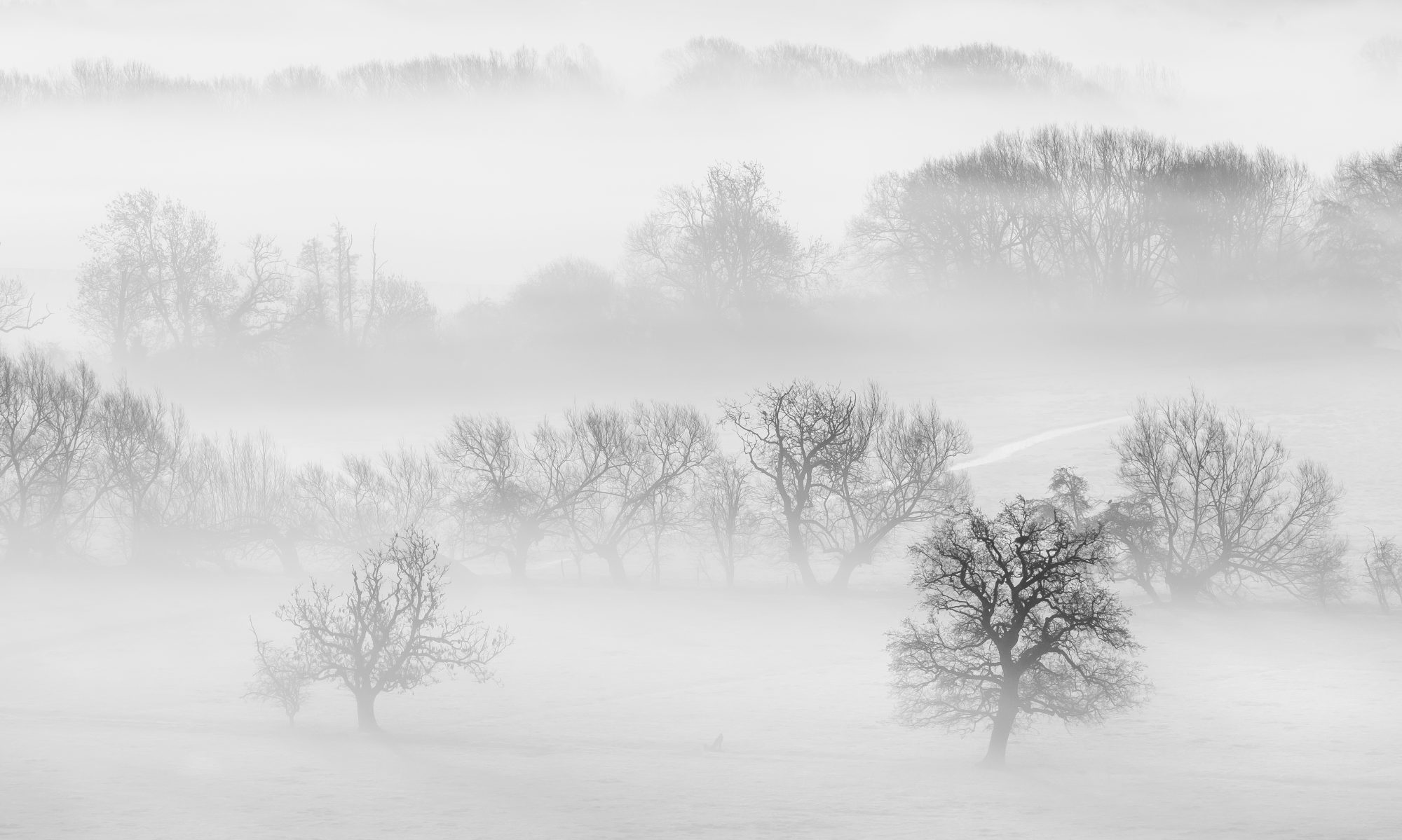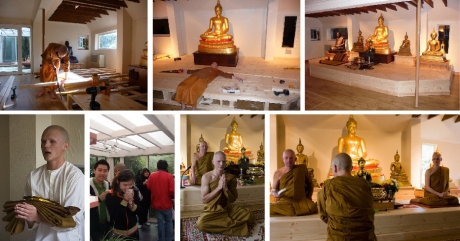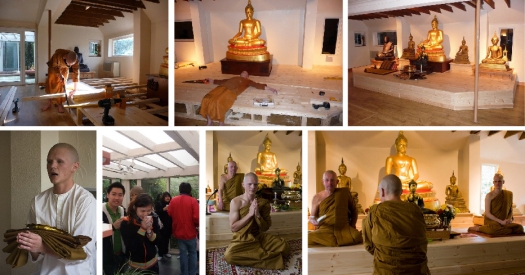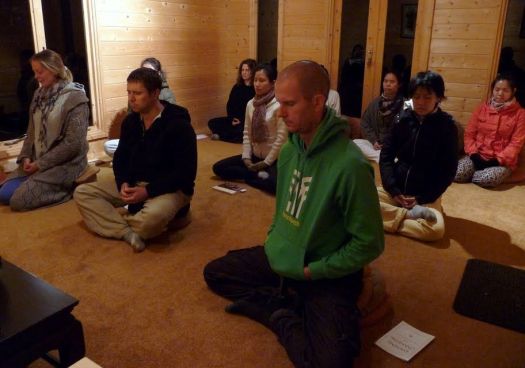When full moon day was a distant memory: The Four Protections: Part 1
Picture a brilliant rainbow in a clear sky. Now cast your eyes over that great arc and you’ll see a tremendous range of colours: from deep blues, to violets, to scarlets, to oranges, to yellows, to greens. In the same way when we cast our mind over the Buddha’s teachings we find a comprehensive array of meditation techniques: from mindfulness of breathing, to contemplation of the body, to loving-kindness and compassion, to contemplation of one’s moral purity. Why did the Buddha teach such a range? Because he understood the diversity of people’s temperaments: their different tastes, tendencies, abilities and obstacles. As such we require different methods to nurture our strengths and extirpate our faults.
Ajahn Chah’s approach to teaching, as with many of the forest masters, respected this refreshing openness. He compared himself to someone who takes round a bowl of fruit: one person takes an apple, another takes a pear, another takes a banana. In this way, he said, ‘everyone gets fed’.
In contrast we sometimes hear of teachers saying that the method they teach is ‘the only way!’ This approach may inspire confidence in their followers but for some of us it seems quite dogmatic and belies the Buddha’s own approach.
The Four Protections
The Four Protections is the name given to a group of some of the most important meditation objects. Taking time to nurture each one will ensure our practice matures into a well-rounded, balanced and effective one. The four are usually developed together, often as a preliminary to mindfulness of breathing, though at other times one or two will take centre stage when a particular benefit is required. They are called protections as they protect the mind’s welfare and happiness. They guide us away from delusion and towards wisdom. The four are: Contemplation of the Buddha, Loving-kindness, Contemplation of the Body, and Contemplation of Death.
Contemplation of the Buddha
It is common for newcomers to Buddhism to have misconceptions regarding the presence of Buddha statues in our shrine rooms. They may even be reluctant to go into such a room, thinking that we worship these images as idols. This is understandable, but – as we know – far from the truth.
Go into any teenager’s bedroom and you’ll no doubt find his walls plastered with posters. There will be Wayne Rooney tearing across the turf, Usain Bolt in a flash green and yellow lycra, Neil Armstrong gliding across the moon. The child has these posters for obvious reasons: to encourage him, to inspire him, to show him what can be achieved through effort and determination. And if he wants to be a famous footballer or runner they continually remind him of his goal.
And this is exactly why we have statues of the Buddha, and also why we contemplate the Buddha: to encourage us, to inspire us, to show us what can be achieved through effort and determination, and to remind us of our goal.
When we contemplate the Buddha we consider what made him the Buddha, what it was that set him apart. Physically he was really no different from you and me: once a person entered a hall full of monks and among them was the Buddha. The visitor could not recognise him. So it was not his physical appearance that made him the Buddha; nor was it his voice or the many unusual happenings that we associate with his life. What distinguished him was his mind. When we contemplate the Buddha we consider a mind that is very different to our own. But also one that we have the potential to emulate.
The Mountain Peak
We can approach this contemplation from a number of angles, in the same way that you might admire the peak of a great mountain from a variety of positions: each view may be slightly different, but they are all of the same peak.
Perhaps our first view of this lofty peak of the Buddha’s mind should be this: its total absence of greed, hatred and delusion. His epithet, ‘Arahant’, means ‘one who is far from defilement’. We can consider this first as it puts before us a very tangible vision of our goal.
Try to imagine a mind where every shade of desire has been abandoned, where each corrosive form of aversion relinquished – a mind that no longer knows these poisons. When we do this we are beginning to understand the Buddha’s experience. At this point it needs to be said that it wasn’t, as some people seem to think, that he still experienced remnants of desire and aversion but owing to his powerful mindfulness was able to immediately dissipate them, as if his mind were a red-hot metal plate and the defilements drops of water falling on that plate; it was that these corruptions did not arise at all. Indeed, they could not arise, for their root had been destroyed.
A mind free of greed and hatred, and consequently of fear and all other derivatives, is a mind that cannot be overcome by any sight, sound, smell, taste or feeling. It remains unperturbed and detached under all circumstances. There is a story of a Brahmin who went to see the Buddha in order to provoke and anger him. Hurling harsh and abusive speech he only managed to exhaust himself while the Buddha calmly sat there, patiently watching the whole charade. Eventually the Brahman gave up and exclaimed how amazing it was than even as he unleashed this torrent of nastiness the Buddha’s face remained clear and bright.
We can begin to grasp what it might be like to have a mind where greed and hatred are no longer active. This is because we know and see them. But of delusion most of us know very little. We cannot see it as we see with it. It is this total absence of delusion that truly set the Buddha’s mind apart. Greed and hatred would still have been operating had he not uprooted the Big Daddy of Dukkha that is delusion. The word ‘Buddha’ literally means the ‘One who Knows’. What did he know? He knew that all things of this world, of all conditioned existence, from the mountains, trees, and stones, to palaces, bricks and mortar, to every component of his mental and physical makeup, was, without exception, impermanent, unsatisfactory, and without self, soul or substance.
It is this comprehension of last of the Three Characteristics – the absence of any self, soul or substance in anything – that I personally find very inspiring. When contemplating the Buddha I might imagine being in the presence of someone whose mind was free of all notions of ‘I’, ‘me’ and ‘mine’. What would that be like?You would see his body; yet in his state of knowing there would be no delusion that that body possessed, or was possessed by, a self. You would know that in his mind there would be feelings, perceptions, mental formations and consciousness; yet in his state of knowing there would be no delusion that these mental factors possessed, or were possessed by, a self. What would his mind have been like? – I wonder. If any goal is worth pursuing it is this one: to be free of all notions of ‘I’, ‘me’ and ‘mine’.
“The greatest happiness of all is to be rid of the conceit: ‘I am’.”
The Ten Perfections and Mastery of Mind
Gazing at the peak from another angle we can consider his mastery of each of the Ten Perfections. For those of you who don’t know, they are: generosity, virtue, renunciation, wisdom, truthfulness, energy, patience, determination, loving-kindness, and equanimity. When contemplating the Buddha from this perspective we reflect that in terms of developing these perfections there was nothing left for him to do. In other words he could be no more generous, no more wise, no more patient, no more determined, no more virtuous, no more loving, no more equanimous. Think about that.
And then we can consider his mastery of the practice of concentration. There is an account of when he was staying in a barn on retreat. While meditating in a doorway a violent thunderstorm tore across the sky. Great claps of thunder pounded the atmosphere and tremendous bursts of lightning electrified the sky. After it had passed a man went to find the Buddha to see if he was all right. The Buddha, on being approached, replied that he hadn’t noticed the storm. Such were his powers of concentration.
And we witness his mental dexterity as he was about to pass away. Entering the first jhana he quickly passed through to the second, the third, the fourth, all the way up to the ninth – which is the cessation of perception and feeling. It is said this final attainment is accessible only to the Non-returner and Arahant. It is the epitome of mental concentration. At this point Ananda declared that the Buddha had passed away. But the Venerable Anuruddha exclaimed the Blessed One was still alive, but had attained the cessation of perception and feeling. He then arose from that attainment and glided though the preceding eight back to the first, from where he again moved through to the fourth. He then attained Final Nibbana.
These states of concentration, it must be said, are extraordinary achievements in their own right. And the Buddha traversed them with the agility of a young child skipping through the playground.
To have a mind like the Buddha’s
We have admired the mountain peak from a number of view points. There are of course others but I think these are the most breathtaking.
When it comes to actually contemplating the Buddha as a meditation object we can simply recite: ‘The Buddha, the Buddha, the Buddha’, or ‘Buddho, Buddho, Buddho’, or we can imagine a favourite statue or picture, or even what it would be like to be in his presence. And while we do these things we allow our mind to explore and investigate the nature of the Buddha’s mind. Doing this can cause determination and rapture to arise – rapture at the prospect of having a mind such as his, a mind totally free from all defilement, from all sense of me and mine, from all suffering.
.
From the elements, to compassion, to loving-kindness, to mindfulness of breathing, to the contemplation of one’s purity of virtue: the spectrum of meditation subjects taught by the Buddha is diverse. But why did he teach such a range? For two main reasons, it seems.
Firstly, because people are different. We have different tastes, talents and tendencies, and different obstacles to overcome. As such, one size does not fit all.
In line with this approach, Ajahn Chah’s way of teaching – as with many of the Thai forest masters – was refreshingly open. He compared himself to someone who takes round a bowl of fruit: one person takes an apple, another takes a pear, another takes a banana. In this way, he said, ‘everyone gets fed’.
And secondly, because of our need to work on the mind from a number of different angles; to gain the benefits of a number of different fruits.
The Four Protections
Four of the most popular and nourishing fruits that the Buddha offered us were grouped together in later years and designated the ‘Four Protections’. They are Contemplation of the Buddha, Loving-kindness, Contemplation of the Body, and Contemplation of Death.
Taking time to develop each one of these meditation objects will ensure our practice matures into a well-rounded, balanced and effective one. They are often cultivated as a preliminary to mindfulness of breathing (or whatever our central practice is), though at times we may decide to devote an entire session to them. An individual protection can also be called upon when a particular benefit is required. They are called protections because they protect the mind’s welfare and happiness and ensure that we remain firmly on course for freedom from all suffering.
Contemplation of the Buddha
It is common for newcomers to Buddhism to have misconceptions regarding the presence of Buddha statues in our shrine rooms. They may even be reluctant to go into such a room, thinking that we worship these images as idols. This is understandable, but – as we know – far from the truth.
Venture into any teenager’s bedroom and you’ll no doubt find his walls plastered with posters. There will be Wayne Rooney tearing across the turf, Usain Bolt in a flash of green and yellow Lycra, Neil Armstrong striding over the moon. The child has these posters for obvious reasons: to encourage him, to inspire him, to show him what can be achieved through effort and determination. And if he wants to be a famous footballer or runner they continually remind him of his goal.
And this is exactly why we have statues of the Buddha. And therefore why we contemplate the Buddha: to encourage us, to inspire us, to show us what can be achieved through effort and determination. And to remind us of our goal.
When we contemplate the Buddha we consider what made him the Buddha. Physically he was really no different from you and me: once a person went into a hall full of monks. The Buddha was among them but the visitor couldn’t recognise him. So it was not his physical appearance that made him the Buddha; nor was it his voice or the many unusual happenings that we associate with his life. What distinguished him was his mind. When we contemplate the Buddha we consider a mind that is very different to our own. But also one that we have the potential to emulate.
The Mountain Peak
We can approach this contemplation from a number of angles, in the same way that you might admire the peak of a great mountain from a variety of positions: each view may be slightly different, but they are all of the same peak.
Perhaps our first view of this lofty peak of the Buddha’s mind should be this: its total absence of greed, hatred and delusion. His epithet, ‘Arahant’, means ‘one who is far from defilement’. We can consider this first as it puts before us a very tangible vision of our goal.
Try to imagine a mind where every shade of desire has been abandoned, where each corrosive form of aversion relinquished – a mind that no longer knows these states. When we do this we are beginning to understand the Buddha’s experience. At this point it needs to be said that it wasn’t, as some people seem to think, that he still experienced remnants of desire and aversion but owing to his powerful mindfulness was able to immediately dissipate them, as if his mind were a red-hot metal plate and the defilements drops of water falling on that plate; it was that these corruptions did not arise at all. Indeed, they could not arise – they had all gone, for their root had been destroyed.
A mind devoid of greed and hatred is a mind that cannot be overcome by any sight, sound, smell, taste or feeling. It remains in a state of non-attachment and freedom in all circumstances. There is a story of a Brahman who went to provoke and anger the Buddha. Hurling harsh and abusive speech he only managed to exhaust himself while the Buddha calmly sat there, patiently watching the whole charade. Eventually the Brahman gave up and exclaimed how amazing it was that even as he unleashed this torrent of nastiness the Buddha’s face remained clear and bright.
The ‘One Who Knows’
Greed and hatred we know and see. It is therefore within our reach to begin to contemplate a mind which is no longer disturbed by them. But delusion – the root of those two and of all suffering – is a different kettle of fish altogether. Unlike greed and hatred we cannot see delusion because we see with it. It is only once we begin to lift this veil that we can turn around and say ‘Aha! I was deluded!’, in the same way a fish who has spent his life under water comes up, tastes the air, and says: ‘Aha! I was in water!’ Delusion is not knowing and seeing things as they really are. It is precisely the absence in his mind of this one thing that made the Buddha the ‘Buddha’ – the ‘One who Knows’.
What, then, did the Buddha know? He knew that all things of this world – of all conditioned existence – from mountains, trees, and stones, to palaces, bricks and mortar, to every sight, sound, smell, taste, feeling and thought, to his own body and mind, was – without exception – impermanent, unsatisfactory, and without self, soul or substance.
It is this comprehension of the last of the Three Characteristics – the absence of any self, soul or substance in anything – that I personally find very inspiring. When contemplating the Buddha I might imagine being in the presence of someone whose mind was free of all notions of ‘I’, ‘me’ and ‘mine’. What would that be like? I wonder.
“The greatest happiness of all is to be rid of the conceit: ‘I am’.” (Vin. Mv. 1:3)
The Ten Perfections and Mastery of Mind
Gazing at the peak from another angle we can consider his mastery of each of the Ten Perfections. For those of you who don’t know, they are: generosity, virtue, renunciation, wisdom, truthfulness, energy, patience, determination, loving-kindness, and equanimity. When contemplating the Buddha from this perspective we reflect that in terms of developing these perfections there was nothing left for him to do. In other words he could be no more generous, no more wise, no more patient, no more determined, no more virtuous, no more loving, no more equanimous. Think about that.
And then we can consider his mastery of the practice of concentration. There is an account of when he was staying in a barn on retreat. While meditating in a doorway a violent thunderstorm tore across the sky. Great claps of thunder pounded the atmosphere and tremendous bursts of lightning electrified the sky. After it had passed a man went to find the Buddha to see if he was all right. The Buddha, on being approached, replied that he hadn’t noticed the storm. Such were his powers of concentration.
And we witness his mental dexterity as he was about to pass away. Having made a prior determination he entered the first jhana and quickly passed through to the second, the third, the fourth, all the way up to the ninth. It is said this final attainment – the epitome of mental concentration – is accessible only to the Non-returner and Arahant. At this point the Venerable Ananda declared that the Buddha had passed away. But the Venerable Anuruddha exclaimed the Blessed One was still alive but had attained the Cessation of Perception and Feeling. Arising from that attainment the Buddha glided through the preceding eight back to the first, from where he again moved through to the fourth. It was here that he attained Final Nibbana.
These states of concentration, it must be said, are extraordinary achievements in their own right. And the Buddha traversed them with the agility of a young child skipping through the playground.
To have a mind like the Buddha’s
We have admired the mountain peak from a number of view points. In the course of contemplating the Buddha you may find other views that are just as breathtaking.
When it comes to actually contemplating the Buddha as a meditation object we can simply recite: ‘The Buddha, the Buddha, the Buddha’, or ‘Buddho, Buddho, Buddho’, or we can imagine a favourite statue or picture, or what it would be like to be in his presence, or we can read his words and the stories about him. And while we do these things we allow our mind to explore and investigate the nature of the Buddha’s mind. Doing this can cause determination and rapture to arise – rapture at the prospect of having a mind such as his, a mind totally free from all defilement, from all sense of ‘me’ and ‘mine’, from all suffering.
.
In Part 2 we will look at the second Protection: Loving-kindness
which will hopefully appear on:
the new moon day, Saturday 19th September
.


















